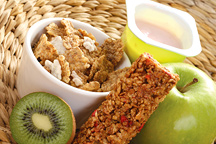Fiber Facts
Prebiotics and the Digestive Health Connection
By Lorraine Niba, PhD
Just a few years ago, surveys typically showed consumers were not particularly thrilled about words such as digestive health, regularity or laxation on food product labels. No one wanted to think about digestive discomfort or colon cleansing while shopping for food. Sure, they wanted the products, but would rather not think about it or be told about it on their food labels. Well, it's clearly a new day! An astounding 76 percent of surveyed consumers believe foods contain components that can improve digestive health, according to the 2007 Health Focus Trend Report. Digestive health and regularity finally seem to be out in the open. The commercials abound - even "Saturday Night Live" recently took a turn with a hilarious spoof of "regularity yogurt." As the audience howled with laughter, Dannon's Activia yogurt was racking up millions in sales. Information Resources Inc.'s 2007 New Product Pacesetters Report indicates the product clocked in among the top five best new food products in terms of sales for 2006-2007.
 Our traditional understanding of fiber and its nutritional benefits has been mainly in the area of regularity. Fiber keeps us regular; we know that. Despite this knowledge, however, there has been a huge discrepancy in actual fiber intake in the United States. While the recommended daily intake of fiber is 25-38 grams per day, the vast majority of Americans consume far less. A 2001 U.S. Department of Agriculture nutrient intake survey showed the average fiber intake for women was only 12-14 grams per day. Men's fiber consumption was slightly higher, at 16-18 grams per day.
Our traditional understanding of fiber and its nutritional benefits has been mainly in the area of regularity. Fiber keeps us regular; we know that. Despite this knowledge, however, there has been a huge discrepancy in actual fiber intake in the United States. While the recommended daily intake of fiber is 25-38 grams per day, the vast majority of Americans consume far less. A 2001 U.S. Department of Agriculture nutrient intake survey showed the average fiber intake for women was only 12-14 grams per day. Men's fiber consumption was slightly higher, at 16-18 grams per day. Fortunately, that trend is changing. Breakthrough research from as early as 1986 in the journal Gastroenterology highlighted the beneficial effects of colonic bacterial fermentation of complex carbohydrates such as fiber. Since then, multiple additional studies by leading researchers in renowned journals such as the British Journal of Nutrition and the American Journal of Clinical Nutrition have provided even more insights into this critical process. This has translated into newly available products for consumers. We have products with probiotics (made up of mainly the bacteria), and overall there are more fiber products than ever. Savvy consumers are perking up and taking notice. In this revitalized world of fiber and digestive health, how do we ensure we are getting the best of these benefits? Prebiotics and Probiotics 101 These two very similar-sounding terms - prebiotics and probiotics - are complementary to each other. They work together to provide the maximum health benefits. Probiotics, however, are much more widely known. Products labeled as probiotics are now available in the refrigerated case of virtually every mainstream grocery store. Probiotics are simply bacteria that have been shown to have beneficial health effects in humans. When we are born, the colon has a healthy population of bacteria, known as intestinal flora. These include bacteria like lactobacilli. As we grow and modify our diets, this population of bacteria is modified to the point most adults are seriously lacking. Fortunately, these bacteria can be replenished through the diet. Manufacturers of food products and dietary supplements have developed technologies that allow them to add live bacteria to foods and beverages. Most probiotic products on the market contain live cultures of bacteria like Lactobacilli bifidobacteria. Dannon's mega-product Activia contains live cultures of "Bifidus Regularis." Prebiotics, on the other hand, can simply be described as the food that the bacteria "feed on." This bacterial "feeding" process, of course, is actually fermentation. So far, most of the prebiotics that have been identified are fibers and other nondigestible carbohydrates. When prebiotic fibers are fermented by probiotic bacteria in the colon, the result is the production of carbon dioxide and short-chain fatty acids (SCFAs). There are three types of SCFAs produced: acetate, propionate and butyrate. These short-chain fatty acids are beneficial to digestive and immune health. Fiber, Fermentation and Digestive Health It's estimated that up to 70 percent of the immune system is located in the large intestine. This might seem unfathomable, but it's directly related to the fermentation activity of the probiotic bacteria, which ferment prebiotic fiber in the large intestine. The benefits to digestive health of fermentation and SCFA production in the colon are numerous. Short-chain fatty acids lower the pH of the colon, creating an environment hostile to various pathogens such as clostridia. Populations of pathogenic bacteria are reduced as the population of "good" bacteria increases. The carbon dioxide produced by fermentation also is a substrate for many of the beneficial probiotic bacteria. As their numbers increase, they are able to crowd out the pathogenic bacteria when they compete for binding sites and nutrients in the colon. In fact, researchers have shown that some diarrhea-causing bacteria like E. coli and salmonella are unable to colonize the gut lining in the presence of probiotic bacterial fermentation. This improves immune health.
 Short-chain fatty acids provide energy for the cells that line the surface of the colon, known as colonic epithelial cells or colonocytes. The healthier and more robust these cells are, the better the overall integrity of the colonic wall. A study in the Journal of Surgical Research showed that SCFAs also stimulate protein synthesis in the colonocytes. This enables cell replenishment, building a more resilient colonic cell wall. This then protects the individual from foreign materials (toxigens) that would otherwise penetrate the wall.
Short-chain fatty acids provide energy for the cells that line the surface of the colon, known as colonic epithelial cells or colonocytes. The healthier and more robust these cells are, the better the overall integrity of the colonic wall. A study in the Journal of Surgical Research showed that SCFAs also stimulate protein synthesis in the colonocytes. This enables cell replenishment, building a more resilient colonic cell wall. This then protects the individual from foreign materials (toxigens) that would otherwise penetrate the wall. Studies in rats have shown that butyrate helps with the muscles of the colon and with intestinal motility. While this has not yet been studied in humans, it likely has a similar effect. Intestinal motility helps with laxation and regularity. As a secondary benefit, the lower pH of the colon helps to improve the absorption of minerals such as calcium and magnesium. The levels of prebiotic fiber needed to produce this effect differ among the different types of fiber. Some fibers are fermented to a greater extent and therefore produce a more noticeable effect. Not All Fibers Are Prebiotics One of the most important aspects of fiber's effect on digestive health is that not every fiber is a probiotic; i.e., not every fiber is fermented by the probiotic bacteria. Colonic bacteria only have the ability to metabolize and digest certain fibers. There are many fibers fermented by bacteria, but several others are not fermented. Soluble fibers (oat beta-glucan, inulin and digestion-resistant dextrins) are prebiotic and are fermented to produce these benefits. On the other hand, fibers such as cellulose and psyllium are not prebiotic and therefore not fermented. In general, the majority of insoluble fibers are not prebiotic. Another important point to note is that the physical structure of the fiber determines how much of it is fermented, and how rapidly it is fermented. Certain fibers with shorter chains and less complex structures are fermented much more quickly, while more complex fibers are fermented more slowly. Consumers Are Seeking Digestive-Health Products Surveys show American consumers are actively looking for products that contain fiber. Over the past five years, the number of consumers increasing their use of fiber has risen steadily. A Health Focus Trend Report showed that in 2006, more than 42 percent of consumers reported they were actively increasing their fiber intake, while 9 percent reported increasing their use of carbohydrates that promote digestive health. And the International Food Information Council's Consumer Attitudes Survey showed that in 2007, consumers ranked fiber as a top 10 functional food, actually rating it higher than green tea. More Products Than Ever Food manufacturers have obviously responded to consumers' demand for fiber and digestive-health products, and there are now more products with fiber or digestive-health claims in the marketplace. In fact, according to the Global New Products Database, the number of new products in 2006 with a fiber descriptor on the label surpassed the number of new products with more traditional and established claims like "added calcium" or "reduced fat." Even more astounding, the number of new products with digestive-health claims introduced into the marketplace was second only to products with a vitamin fortification claim. In 2007, the term prebiotics was used on at least 54 food and beverage products, a remarkable increase from approximately 23 a year earlier. The traditional categories for fiber were bakery or cereal products. While these products still are abundant, the discovery of new sources of soluble fibers in particular has enabled food and beverage manufacturers to add fiber to nontraditional products, such as beverages and dairy products. There are now prebiotic fibers in beverages, yogurt and bars. Dietary supplements containing prebiotic fibers also are very common. Most consumers are now quite familiar with the term probiotics. Far fewer, however, have heard of the term prebiotics. While it may take much longer for prebiotics to gain the same level of recognition, there already are many products on the market with the proven benefits. There also are products that combine both probiotics and prebiotics. These are known as synbiotics. General Mills' Yoplait yogurt, for instance, contains a combination of probiotic bacteria and prebiotic fiber. The physiological benefits of fiber are still being discovered, particularly as it relates to digestive health, but we have made truly great strides in a relatively short period of time. Fiber-based colon cleansing and detoxification products are also now being introduced into the market. The market for digestive-health products is projected to grow 14 percent from 2004 to 2009, as indicated by data from the market research firm Datamonitor. As the science improves, there will be even better products that have the best taste, convenience and efficacy to truly deliver these benefits.
Page printed from:
http://www.toyourhealth.com/mpacms/tyh/article.php?id=1094&no_paginate=true&no_b=true
| 
